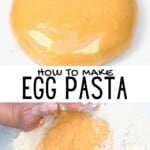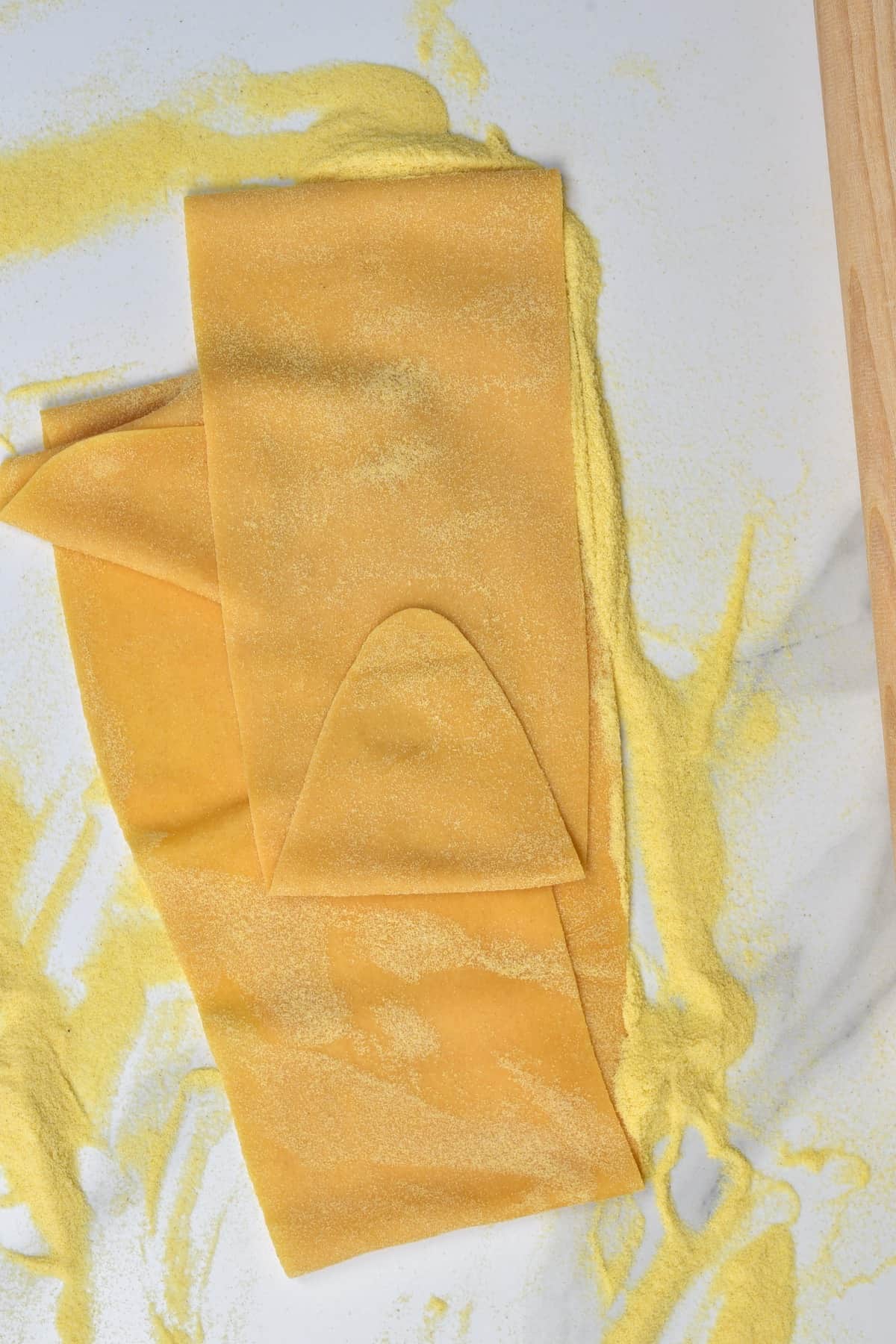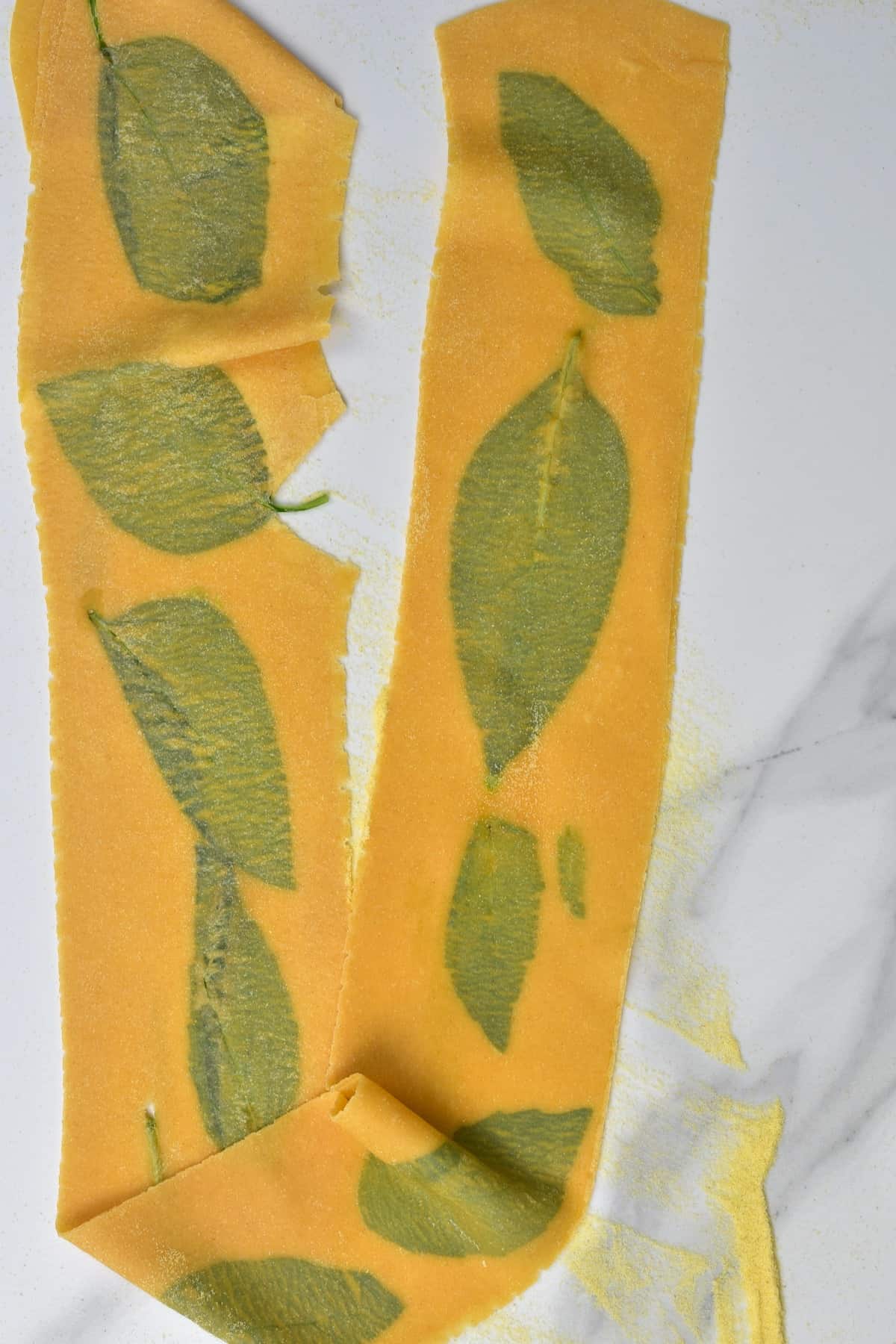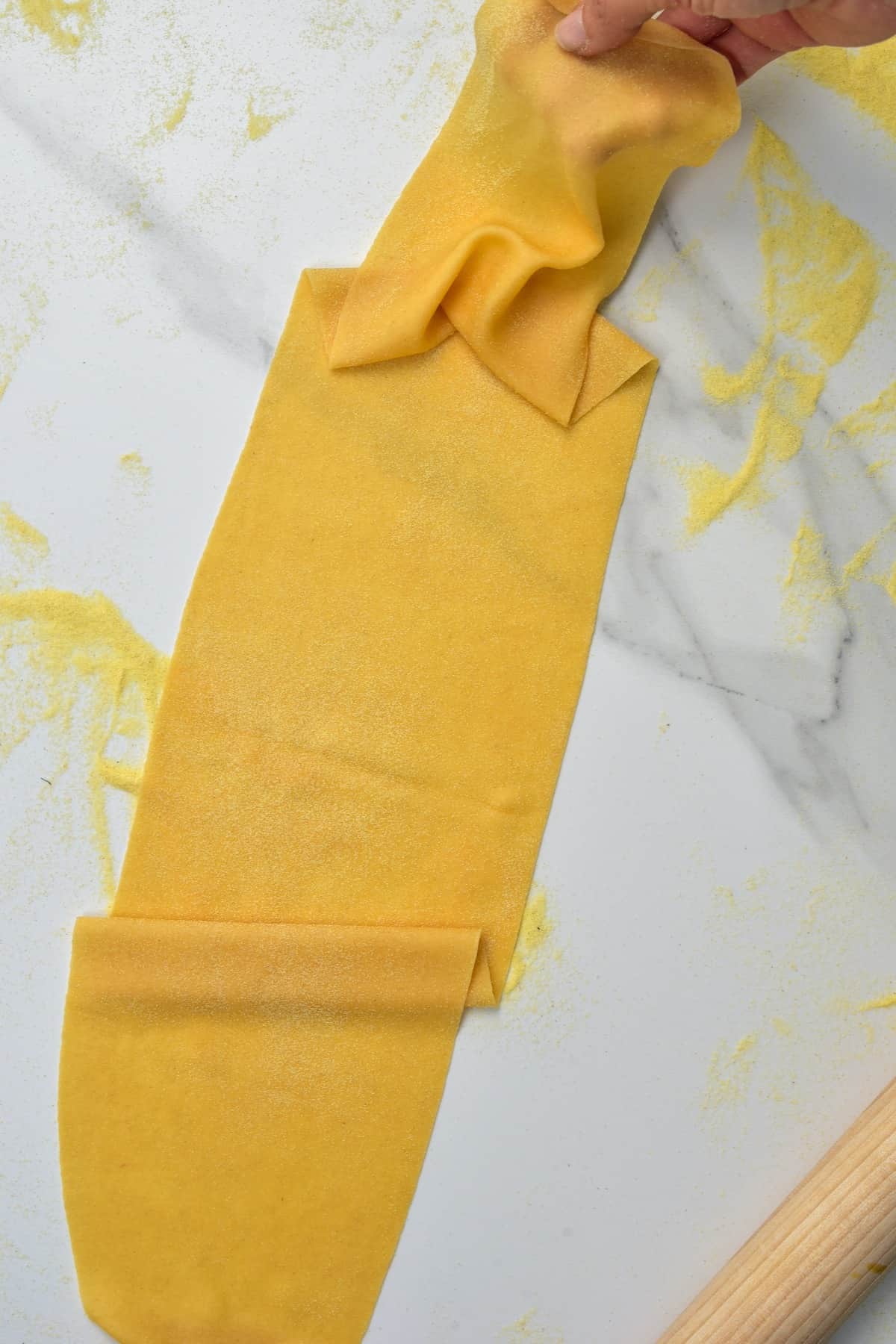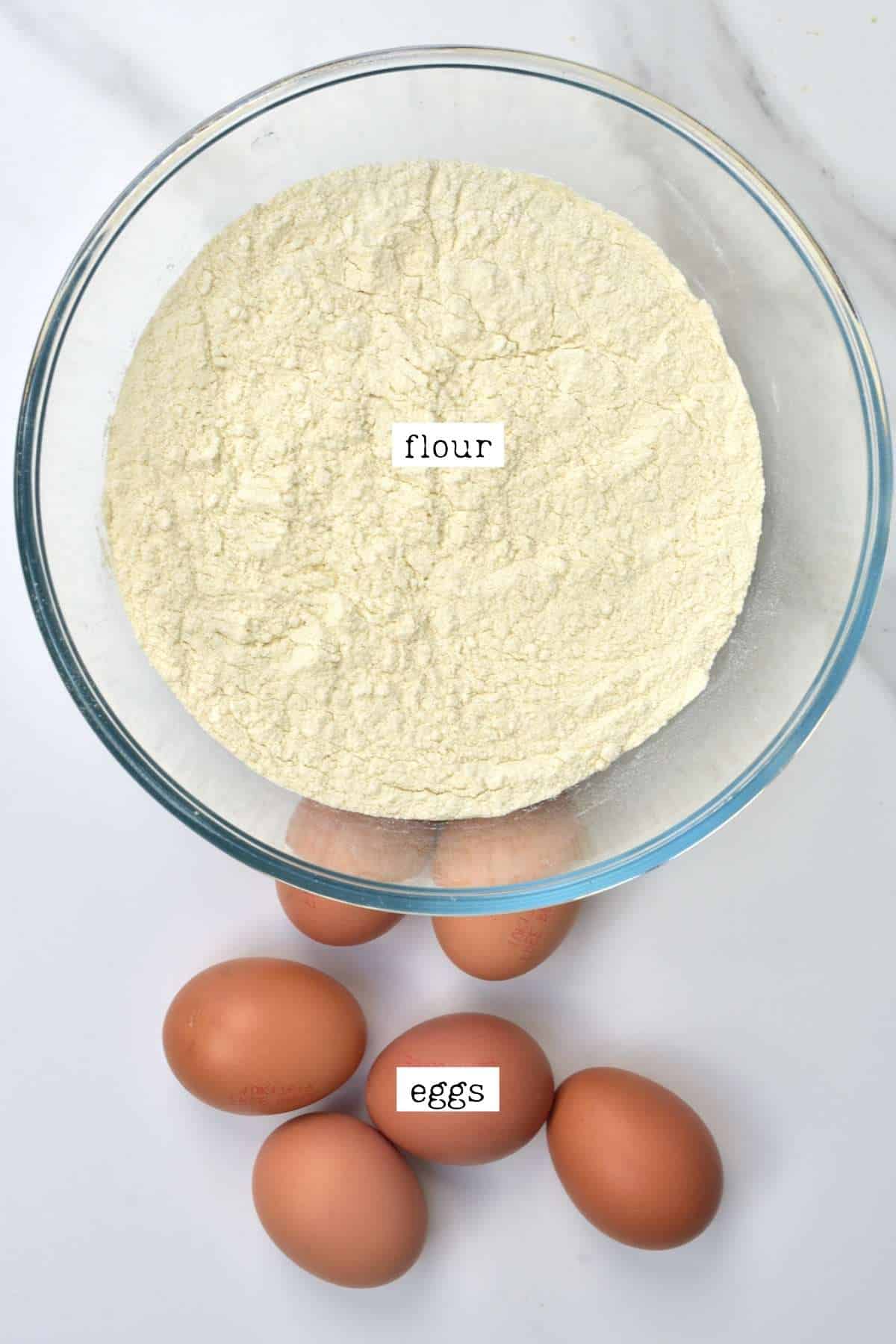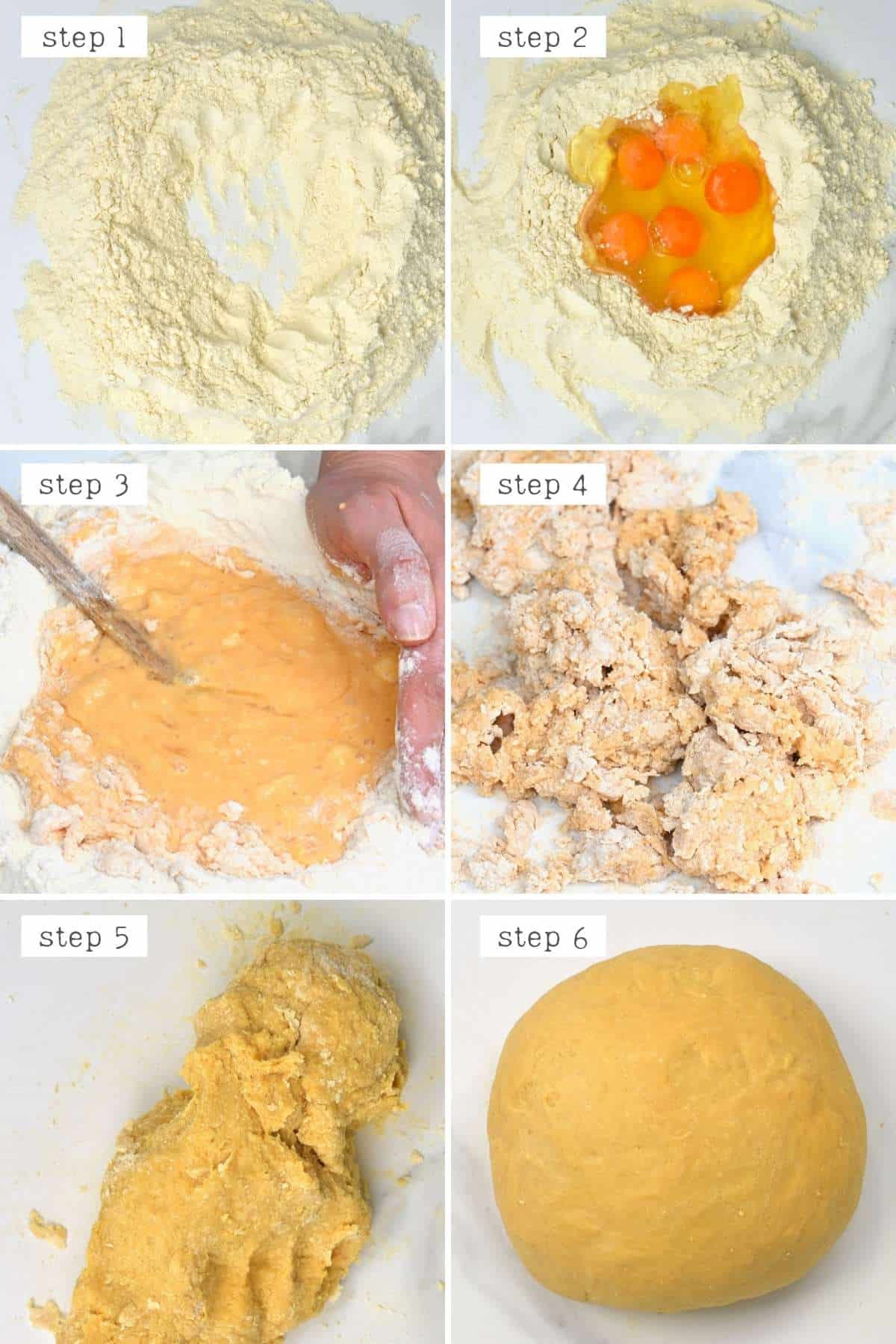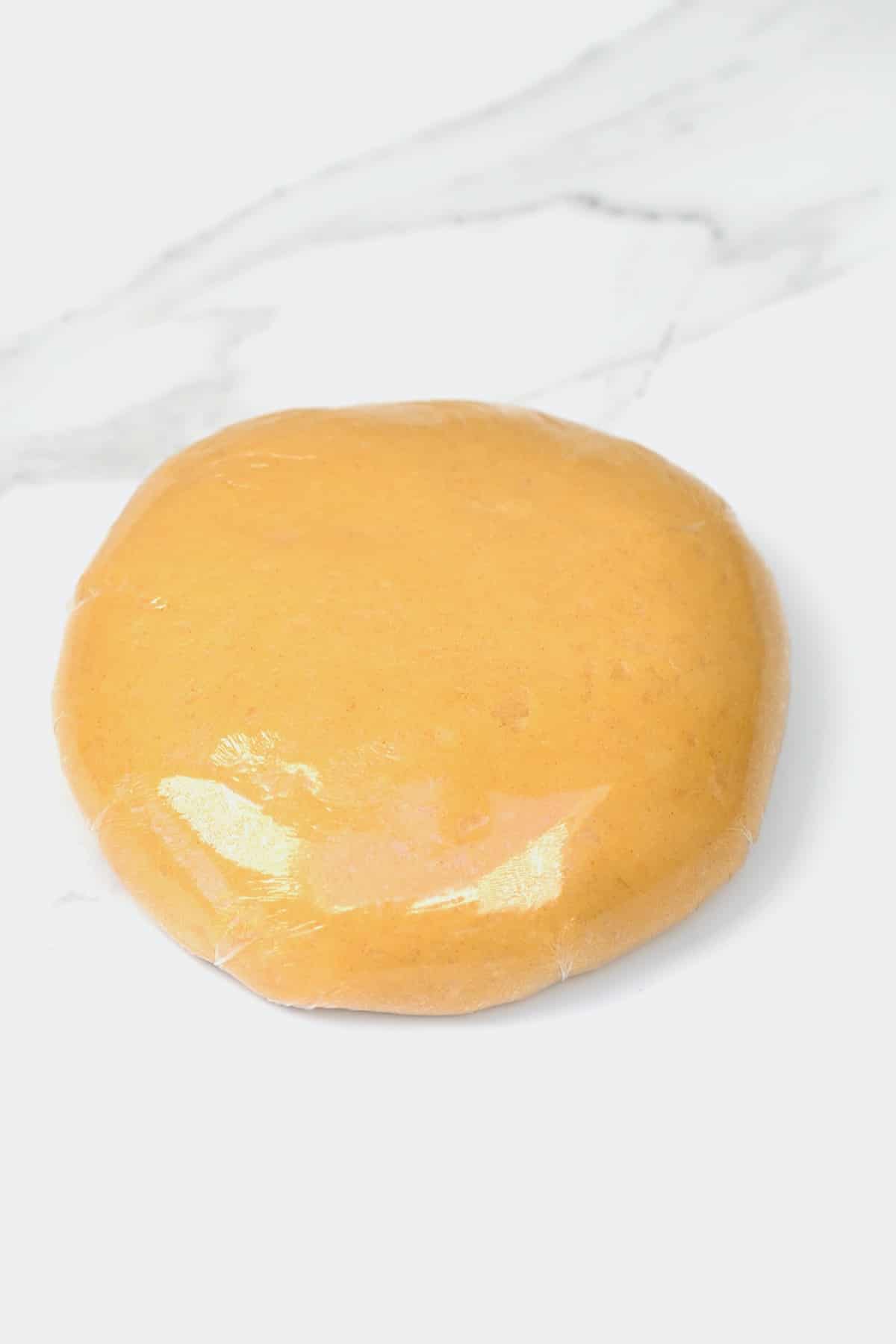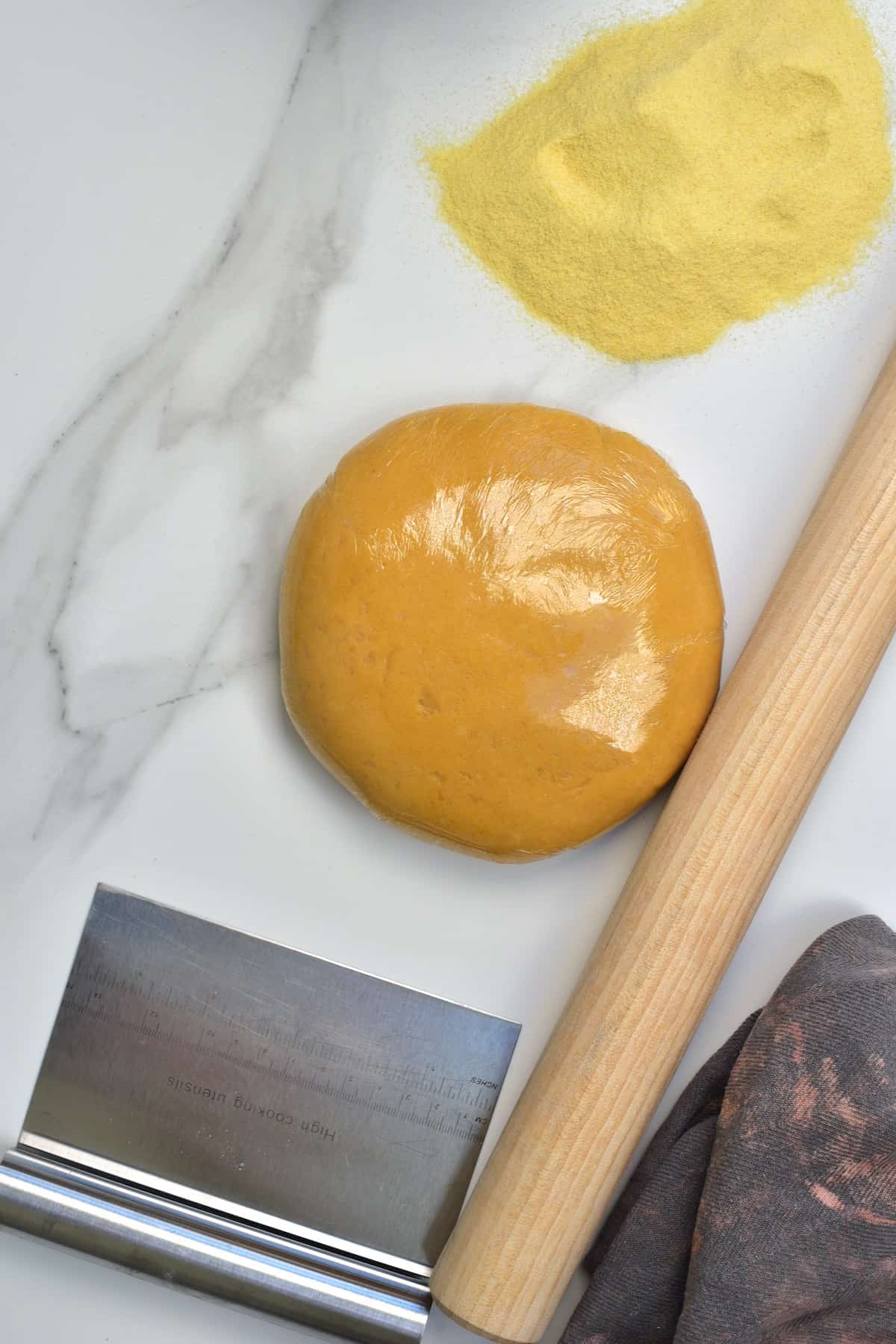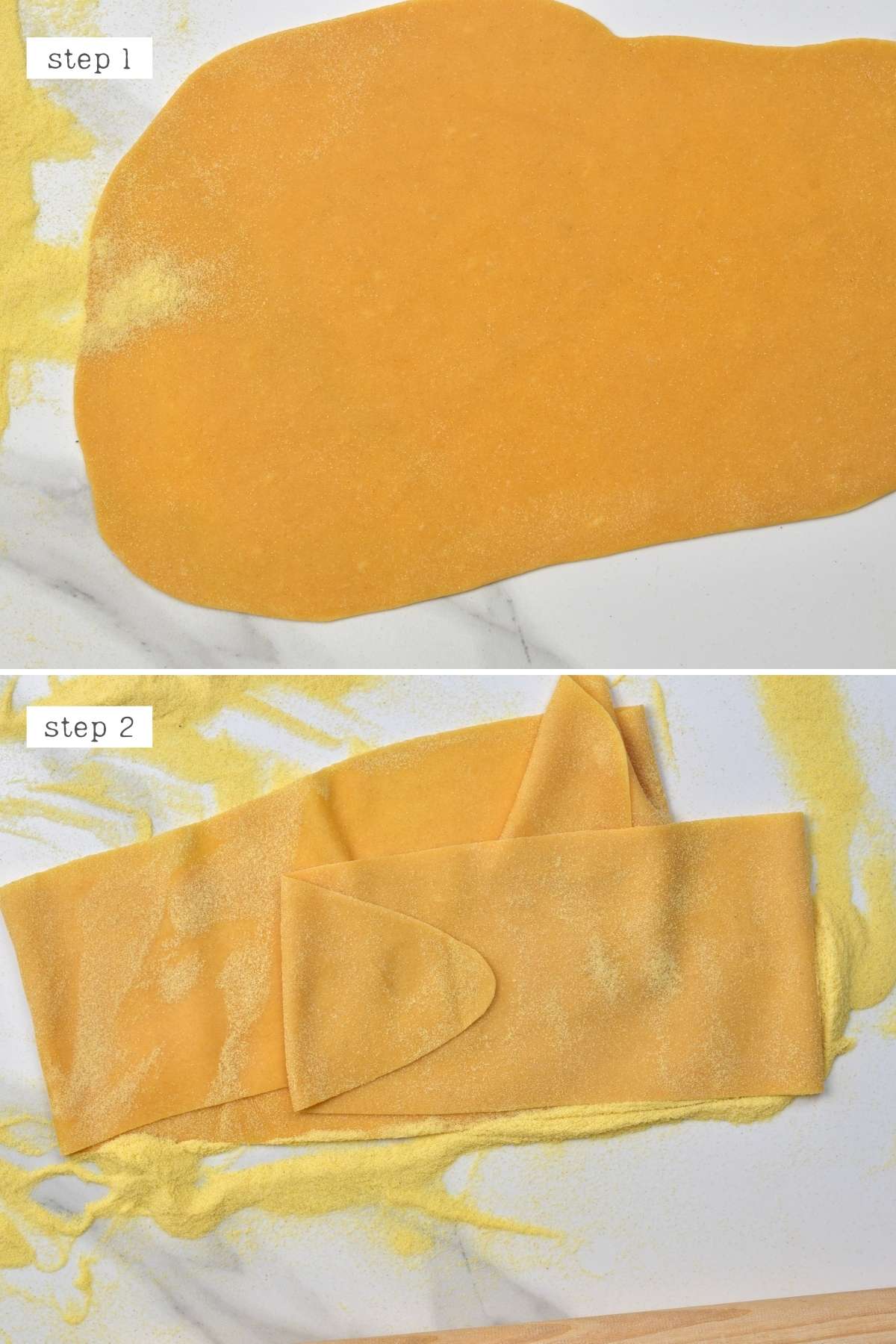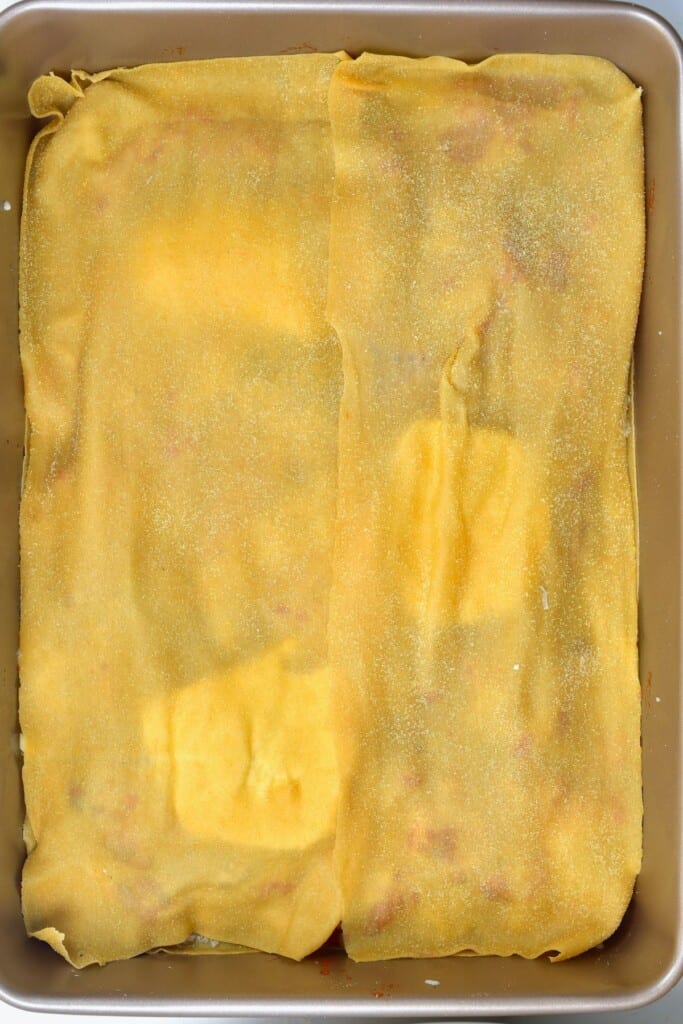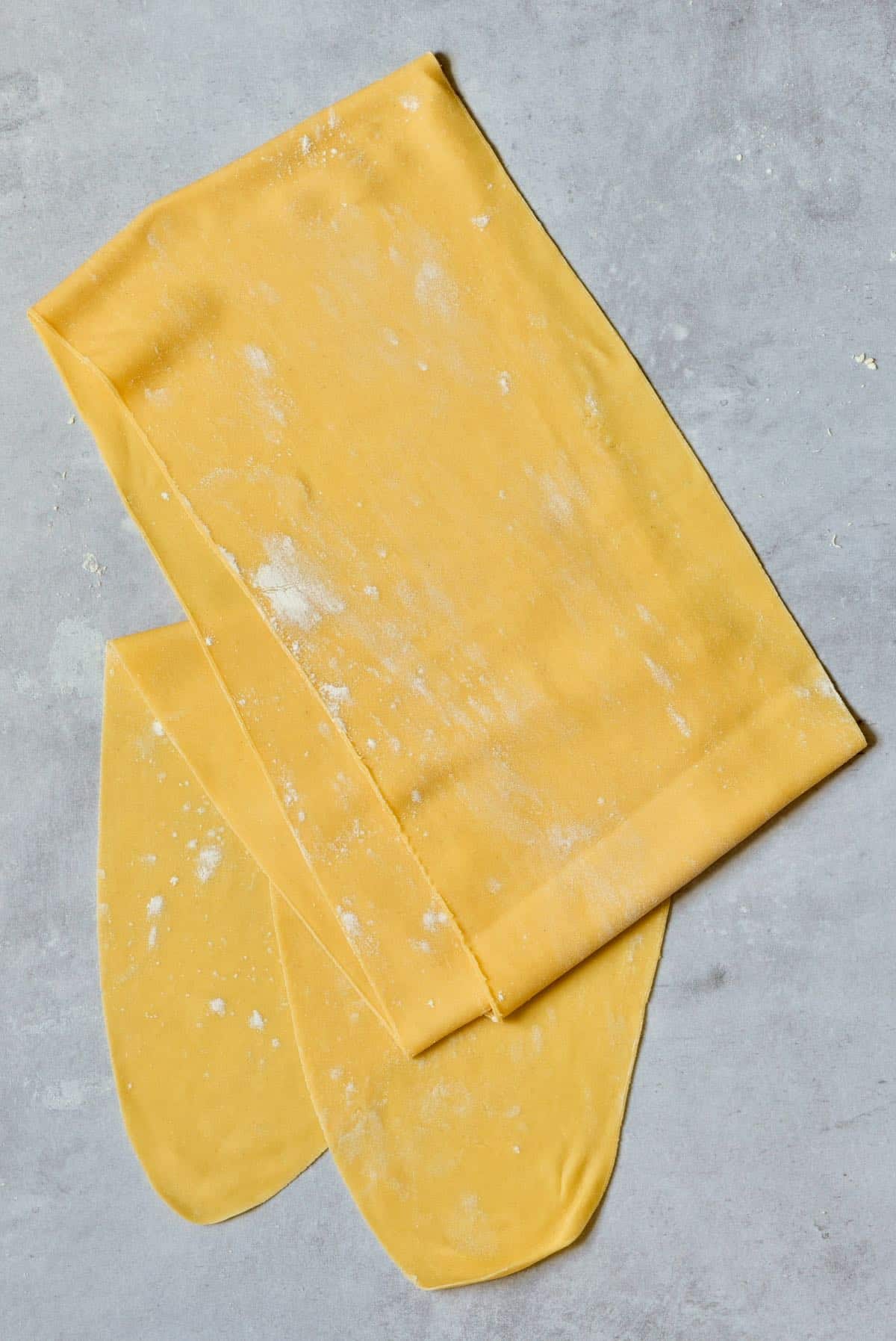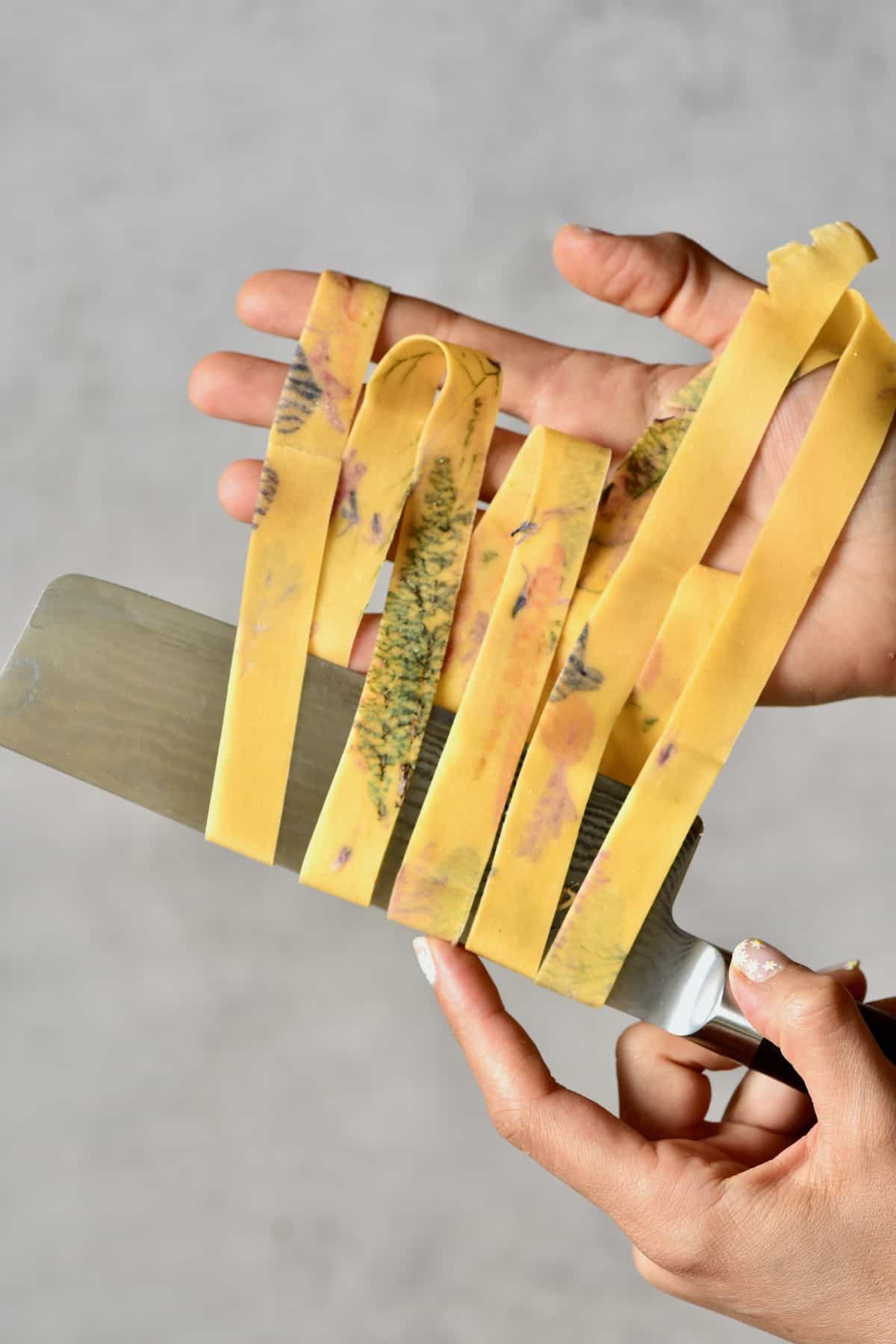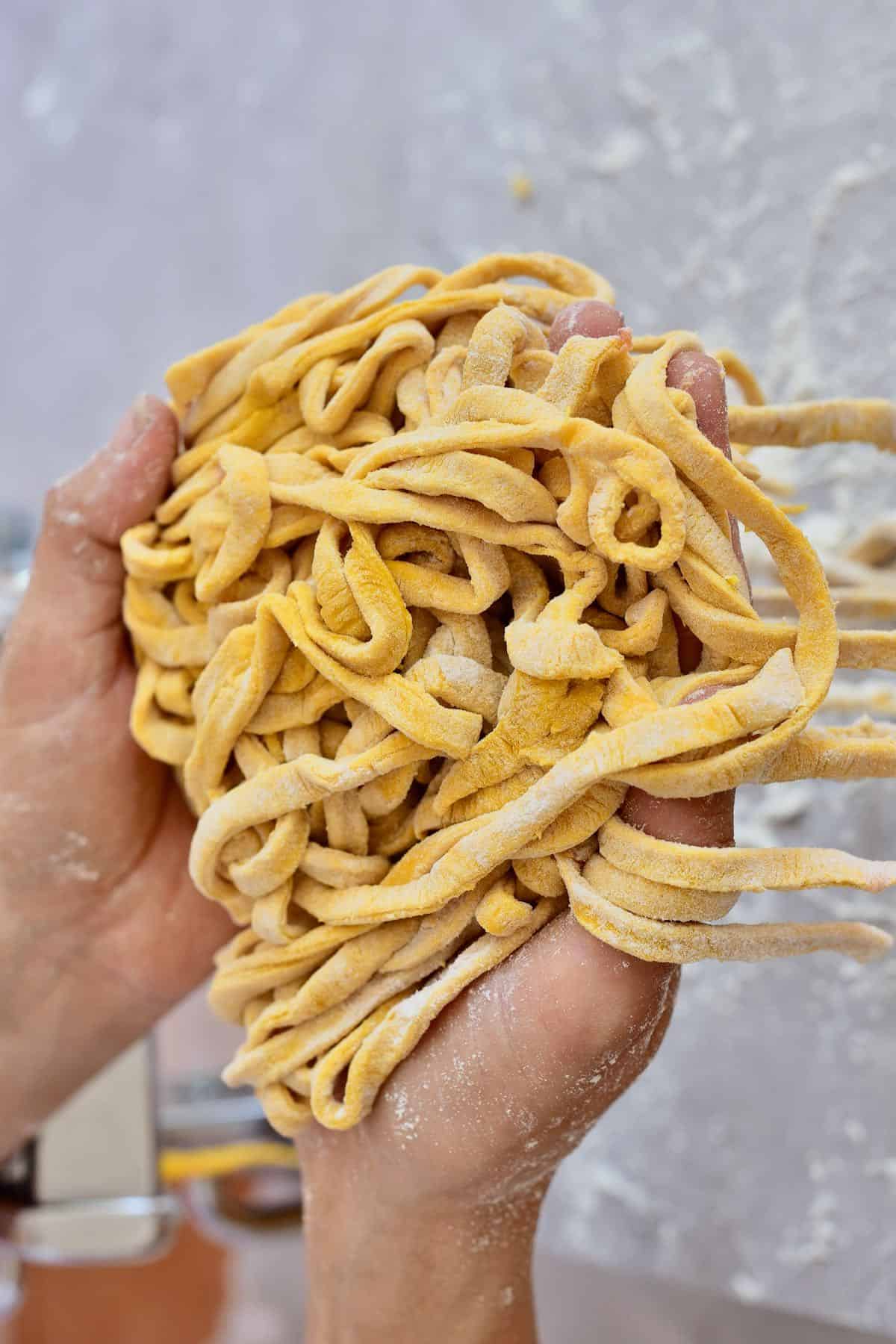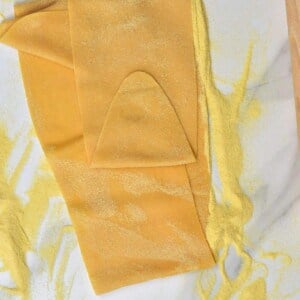It occurred to me last week that although I’ve shared recipes for vegan pasta (also called ‘pasta Bianca dough’), chickpea flour pasta, oat pasta, homemade pappardelle pasta, and spinach ravioli (along with other homemade pasta recipes!), I’d never shared a recipe for simple, plain homemade egg pasta. Making fresh pasta is not only surprisingly simple, but it’s super fun to do as well, and this egg pasta recipe is one of my all-time favorites. When making pasta from scratch, all you need is TWO ingredients too, 00 flour and large eggs! Use a stand mixer if you have one. Otherwise, the homemade pasta dough can be kneaded by hand. You can also hand-roll and shape the pasta or use a pasta machine/extruder – it’s up to you! Homemade pasta without a machine can be just as simple to make – all you need is a rolling pin!
What Is 00 Flour?
00 flour is a type of finely ground Italian flour most often used for pizza and pasta and within cakes and pastries. In Italy, the number associated with the flour is how finely it has been ground (and how much of the germ and bran are removed). 00 and 0 are the finest, while 2 isn’t as finely ground, like wholemeal flour. It’s also important to note that the number rating doesn’t correlate with protein content as even 00 flour can vary in content. 00 flour isn’t 100% necessary for fresh pasta, though. In fact, you can substitute all-purpose flour. However, pasta made with AP flour tends to require longer cooking times and is less tender, with a chewier texture. I do think it’s important to note, though, that several Italian friends have pointed out to me that they don’t rely on 00 flour for pizza or pasta. Instead, they use flour specifically labeled as ‘pizza flour’ for pizza and often using the ‘pasta Bianca dough’ with a combination of 00 and semolina flour (‘semola flour’) or durum flour (which is finer than semolina flour) for pasta.
What other flour can be used for homemade pasta?
Along with 00 flour, semola flour (aka semolina flour) and durum flour are the other main choices. Both are made using durum wheat, but durum flour is finer in texture. Semola flour has less elasticity, making it perfect for shaped pasta like penne and macaroni, and will help them keep their shape while cooking. It also helps the pasta sauce cling better. In comparison, durum flour is much finer and more pliable – more often best used for softer pasta shapes. For example, spaghetti or lasagna sheets. It can also be a good inclusion for making a soft enough dough (yet with enough strength) to push through an extruder.
Egg Pasta Ingredients
Flour: having said all the above, I use 00 flour for my homemade egg pasta as I love the results. However, you could use a combination of 00 and durum/semola flour for extracted pasta or even use all-purpose flour if that’s all you have. Eggs: I like to use large, free-range, room-temperature eggs when making homemade pasta dough. Use the highest-quality free-range eggs you can for the best results. The ones I use have a gorgeous deep orange yolk color for a lovely yellow pasta. (Optional) olive oil: you can add a splash of olive oil to the dough to create a more tender pasta dough.
If you want to use this pasta dough for creating extruded pasta shapes like penne pasta or even for spaghetti, I recommend using a 1:1 ratio of 00 flour and durum flour or semola flour, which creates a slightly stronger dough.
How to Make Homemade Pasta
Step 1: Prepare the egg pasta dough Place the flour on a clean working surface, create a well in the middle, and then add the eggs to the well. Once you have a rough dough, knead it with your hands, making sure to stretch and pull the dough until it becomes smooth and elastic. This process will take a while, so be patient- it usually takes me around 10 minutes. While kneading the dough, it may initially feel like you need more water or flour but don’t add in anything yet – just keep working with it. If it continues to stick to your hand even when smoother-looking, you may need an extra spoonful of flour. If it’s still a bit crumbly, then add a spoonful of water. Step 2: Rest the dough Allow the dough to rest for 15 minutes, wrapped tightly with plastic wrap. Once rested, it should be soft and tender, and easy to work with. Meanwhile, as it rests, you can prepare your tools for shaping the homemade pasta dough, including:
Extra flour to dust the surface, or use semolina (semola flour) EITHER a rolling pin or pasta machine (if you have one) Knife or bench scraper to cut the dough. Kitchen towel to cover the rolled egg pasta sheets so they don’t dry.
Step 3: Roll and shape the pasta dough. Once it’s rested, divide the dough into 4-6 pieces (these will be easier to work with). To shape the pasta, you’ll then be using one of three methods: using a rolling pin, a pasta machine, or a pasta extruder. Using a pasta extruder If you use a pasta extruder, then simply feed the dough into the extruder, press it through, and toss with a little extra flour/semolina to make sure they don’t stick. The shapes you can make will depend on what disks you have for your extruder but will often contain several diameters of round noodles and flat noodles (like the flat ribbon noodles used for Pad Thai) and certain tube-shaped pasta too. Using a Rolling Pin Use the rolling pin to roll out the dough as thin as it will go. In most cases, we want the egg pasta to be between 2-3mm. Hand-rolled pasta (and pasta sheets) are great for when you want to make pasta including:
Lasagna sheets Pappardelle Tagliatelle Fettucine Spinach ravioli Tortellini Farfalle Orecchiette Cavatelli
For wide homemade pasta noodles (aka ribbon, pappardelle, etc.) Once you’ve rolled out your sheet, cut it to the length you want your noodles to be, trimming off the ends for a rectangular piece (those discarded pieces can be re-rolled). Roll the pasta up, loosely, from the shorter end of the rectangle, then use a sharp knife to cut along the rolled-up sheet to the width of the noodles you want. Unroll the pasta, and those are your noodles. For Lasagna Sheets Once you’ve rolled out the dough, then use your measured bench scraper or a ruler to help measure and cut the lasagna sheets to size. Making them homemade means you can fit them perfectly into any baking dish you own! Use a sharp knife or pizza cutter to cut out the sheets. Feel free to hold the ruler in place over the pasta to cut straight lines. Using a pasta machine Once you’ve divided the dough, flour one piece (liberally) and roughly flatten it by hand, thick enough to fir the first setting of your pasta machine (usually ‘0’). Feed the pasta through the machine and then fold it like a letter (to fit inside an envelope – one side over the other) and repeat 3 more times. Then pass the dough through each setting, slowly making it thinner until you reach your desired thickness. If the dough starts to feel tacky at any point, then sprinkle a little more flour over it. You can then hand cut lasagna and any of the pasta varieties mentioned above. Alternatively, most pasta machines will also come with separate attachments for spaghetti and slightly wider (Fettucine) noodles.
How to cook fresh pasta
If you’re wondering how long to cook egg noodles, it will depend on whether they are fresh, frozen, or dried. To cook fresh egg noodles: Note that if you freeze or dry the pasta, then the cooking time will increase. Add an extra 1-2 minutes for frozen egg pasta and an extra 2-4 minutes for dried egg pasta.
How to store fresh pasta
Storing fresh pasta is super simple as it can be dried, refrigerated, and frozen! The pasta dough can even be made ahead!
Make ahead: you can prepare the homemade pasta dough up to a day in advance and refrigerate it, tightly wrapped in plastic wrap, until you’re ready to continue with the recipe. You can also freeze the dough. However, I suggest you portion it out first and wrap them in two plastic wrap layers to avoid freezer burn. Once frozen, the dough will store for up to a month. Room temp: the fully dehydrated pasta (see below how to do it) will be safe to store in an airtight container for several weeks. However, it’s important to make sure pasta with eggs is fully dehydrated to avoid any germs from the raw eggs. Fridge: once dried, transfer it to an airtight container and store it within the fridge for a couple of days. After this time, the noodles can oxidize and turn an odd grey-ish color – it’s still safe to eat but doesn’t look great. Freezer: to freeze the egg pasta, first allow them to freeze till solid while spread out (not touching or in nests) on a tray (this will stop the noodles/nets from sticking to one another). Then transfer to an airtight container and store for between 1-2 months (or up to 6 months if you fully dehydrated the pasta first). Allow the pasta to thaw in the refrigerator before cooking, or add an extra 30-60 seconds to the cooking time.
How to dry egg pasta
There are a couple of main ways that you can dry the egg pasta, based on what type of shape pasta noodles you’ve made and what tools you have. You can use a drying rack (or even clothes hangers!) to hang any noodles or swirl them into little nests. Lay them on a lightly floured surface to dry out. For larger pasta like lasagna sheets, you can simply lay them on a lightly floured surface in a well-ventilated area to air-dry. You could also use a dehydrator (at 135ºF/57ºC for 2-3 hours). The time it takes to dry out will depend on the temperature and humidity. If you plan on storing the egg pasta in the refrigerator or freezer, then 30-60 minutes is more than enough. To completely dehydrate the pasta then it can take up to 48 hours in some cases (the pasta should snap, not bend!)
How to serve homemade pasta
Here are just a few suggestions on recipes to enjoy your fresh pasta!
Mixed Vegetable Lasagna The Best Beef Lasagna Tiktok pasta Creamy Avocado Pasta Sauce (Green Pasta) Homemade Roasted Tomato Sauce (Homemade Pasta Sauce) Super Creamy Vegan Mushroom Sauce Pasta Tomato and Eggplant Pasta (Pasta Alla Norma) The Best Spaghetti Sauce
Recipe Notes
The color of the pasta: will vary based on the flour and eggs used. I use eggs with deep yolks, which makes richer colored pasta. Semola flour is also more yellow in color, so it will affect the color of the pasta. Be liberal with flouring: dust the pasta machine rollers and all the pasta dough and cut pasta liberally with flour to make sure nothing sticks. Make sure to use large eggs: if you use smaller eggs, then the amount of flour needed will also change. Feel free to season the dough: it’s unnecessary as most of us season the cooking water and the sauce, etc. However, you could also season the dough for extra flavor. Just note that salt will impact the texture of the dough, too. Humidity, flour, and eggs can all impact the dough: depending on where you live, you may find that you need slightly less flour, or you may need to add a little additional liquid in the form of water (1 tsp at a time) to get the dough to the correct consistency. It may take a little practice, but you’ll come to ‘feel’ when your dough needs more flour/liquid.
Other Pasta Recipes
How To Make Oat pasta (3 Ingredient Gluten-free Pasta) Greek Pasta Salad Easy Homemade Potato Gnocchi How To Make Chickpea Flour Pasta Homemade Vegan Pasta All-Natural Homemade Colored Pasta Homemade Ricotta And Spinach Ravioli How to Make Beet Pasta (Pink Pasta Recipe) How To Make Red Lentil Pasta (+ Egg-Free Option) How to Make Spinach Noodles (Green Pasta Dough)
If you try this homemade pasta recipe, I’d love to hear your thoughts/questions below. Also, I’d really appreciate a recipe card rating below, and feel free to tag me in your recipe recreations on Instagram @Alphafoodie!
